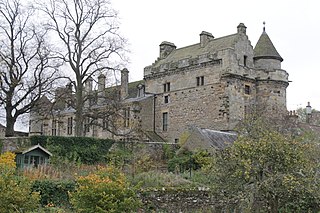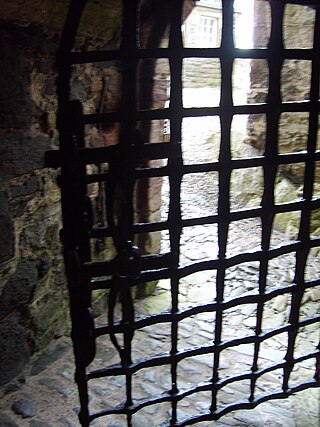This article needs additional citations for verification .(October 2010) |
The Treasurer was a senior post in the pre-Union government of Scotland, the Privy Council of Scotland.
This article needs additional citations for verification .(October 2010) |
The Treasurer was a senior post in the pre-Union government of Scotland, the Privy Council of Scotland.
The full title of the post was Lord High Treasurer, Comptroller, Collector-General and Treasurer of the New Augmentation, formed as it was from the amalgamation of four earlier offices. Of these, the Treasurer and Comptroller had originated in 1425 when the Chamberlain's financial functions were transferred to them. [1] From 1466 the Comptroller had sole responsibility for financing the royal household to which certain revenues (the property) were appropriated, with the Treasurer being responsible for the remaining revenue (the casualty) and other expenditure. [2] The Collector-General, created in 1562, handled the Crown's revenue from the thirds of benefices, and the Treasurer of the New Augmentation was responsible for the former church lands annexed to the Crown in 1587. [3]
From 1581 Queen Elizabeth sent James VI an annual sum of money. [4] In February 1599 the Privy Council declared that the Treasurer would administer this English subsidy, spending it on clothes for the royal family and the household of Prince Henry. [5] In previous years the goldsmith Thomas Foulis and cloth merchant Robert Jousie accounted this money. [6]
All four offices were held by the same person from 1610 onwards, but their separate titles survived the effective merging of their functions in 1635. From 1667 to 1682 the Treasury was in commission, and again from 1686 to 1708, when the separate Scottish Treasury was abolished. From 1690 the Crown nominated one person to sit in Parliament as Treasurer.
The Treasurer-depute was also a senior post in the pre-Union government of Scotland. It was the equivalent of the English post of Chancellor of the Exchequer.
Originally a deputy to the Treasurer, the Treasurer-depute emerged as a separate Crown appointment by 1614. Its holder attended the Privy Council in the absence of the Treasurer, but gained independent membership of the Council in 1587 and sat in the Parliament of Scotland as a Great Officer of State in 1593 and from 1617 onwards.
The following have been identified as treasurers of Scotland. [7]

The final audited accounts of the Lord High Treasurer were public records of Scotland. These survive as an almost complete record from 1473 to 1635 at General Register House in Edinburgh. Even the early accounts were written on paper rather than vellum. The Scots language was preferred over Latin for the expenditure or "discharge" side. The income, of rents and feudal duties, especially the fees on property transactions known as "compositions", was written in Latin. The record of expenses varies considerably over the reigns. For example, as Regent, Mary of Guise paid for her stable, costume, and wardrobe separately and these expenses do not occur in her treasurer's accounts. [12]
There are also surviving duplicate volumes for the years 1574 to 1596. These volumes were kept for many years by the family of the Earl of Leven and Melville, and were deposited in the National Archives of Scotland in 1944. Their exact purpose in royal accounting remains unclear. The layout of these duplicate accounts and the wording of the entries is not an exact replica of the main series. [13]
The manuscripts were published between 1877 and 1978 in thirteen volumes covering up to 1580. The editors silently abbreviated and omitted some material, especially details of making costume. [14] [15]
Historians often refer to the published volumes in references as TA:

The ruins of Linlithgow Palace are located in the town of Linlithgow, West Lothian, Scotland, 15 miles (24 km) west of Edinburgh. The palace was one of the principal residences of the monarchs of Scotland in the 15th and 16th centuries. Although maintained after Scotland's monarchs left for England in 1603, the palace was little used, and was burned out in 1746. It is now a visitor attraction in the care of Historic Environment Scotland.

Falkland Palace, in Falkland, Fife, Scotland, is a royal palace of the Scottish Kings. It was one of the favourite places of Mary, Queen of Scots, providing an escape from political and religious turmoil. Today it is under the stewardship of Ninian Stuart, who delegates most of his duties to The National Trust for Scotland. The Chapel Royal in the Palace is dedicated to Thomas the Apostle, and is also open to the public and reserved for Catholic worship.

A yett is a gate or grille of latticed wrought iron bars used for defensive purposes in castles and tower houses. Unlike a portcullis, which is raised and lowered vertically using mechanical means, yetts are hinged in the manner of a traditional gate or door, and secured by bolts attached to the yett, or by long bars drawn out from the wall or gateway.
William MacDowall was a Scottish priest and Master of Works to Mary, Queen of Scots, her mother Mary of Guise, and James VI of Scotland. The title 'sir' was used in Scotland by a priest without a master's degree. The name appears variously as McDowgall, McDougall, McDowall etc., in printed records, he signed accounts MAKDOUELL.
Robert Barton of Over Barnton was a Scottish landowner, merchant, sailor and politician. He served as Comptroller, Master of the Mint and Lord High Treasurer to James V of Scotland.
John Drummond of Milnab was a 16th-century Scottish carpenter in charge of the woodwork of the palaces, castles and guns of James IV of Scotland and James V of Scotland.

John Chisholm was a 16th-century Scottish soldier and the chief officer, Comptroller and Prefect of the Scottish artillery for Mary, Queen of Scots and James VI of Scotland. He was also keeper of the King's Wark in Leith. Chisholm was a supporter of Mary, Queen of Scots in the years after her exile in England.
The Comptroller of Scotland was a post in the pre-Union government of Scotland.
Servais de Condé or Condez was a French servant at the court of Mary Queen of Scots, in charge of her wardrobe and the costume for masques performed at the Scottish royal court.
John Arnot of Birswick (Orkney) (1530–1616) was a 16th-century Scottish merchant and landowner who served as Lord Provost of Edinburgh from 1587 to 1591 and from 1608 to death. He was Deputy Treasurer to King James VI.

Robert Gourlay or Robin Gourlaw was a wealthy Edinburgh merchant and Customar of Edinburgh who built a renowned house in Edinburgh.
Michael Gardiner was a Scottish artilleryman based at Stirling Castle. The surname also appears as Gardner and Gardenar.
John Acheson was a Scottish goldsmith, mining entrepreneur, and official of the mint.
James Hommyll, was a wealthy merchant in Edinburgh.
Robert Colville of Cleish (1532–1584) was a Scottish courtier.

James Inglis was a Scottish tailor who served James VI of Scotland.
Jerome Bowie was a servant of James VI of Scotland as a sommelier and Master of the Wine Cellar, in charge of the purchase and serving of wine.
Alexander Durham was a Scottish courtier and administrator.

In the United Kingdom, the Great Officers of State are traditional ministers of the Crown who either inherit their positions or are appointed to exercise certain largely ceremonial functions or to operate as members of the government. Separate Great Officers exist for England and Wales, Scotland, and formerly for Ireland, though some exist for Great Britain and the United Kingdom as a whole.

Drinksilver was a kind of tip or gratuity given to artisans in Early Modern Scotland, a sum of money suitable for buying drinks and celebrating. Records of payments give insights into labour, service, and patronage.